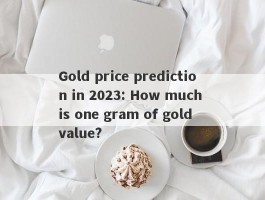Golden History high -level surprise: When will it be the pole?
Golden History high: the barometer of the financial market
Gold historical high is the highest level of gold prices in a certain historical cycle.In the financial market, the high level of golden history is not only a indicator of price trends, but also a comprehensive reflection of market sentiment, economic expectations and global political risks.
The importance of golden history is self -evident.It is not only a barometer in the financial market, but also a mirror for investors' psychological state and market fluctuations.When economic instability and political risks intensify, investors often seek risk aversion assets, and gold is often the first choice, so its price often reaches a historical high.Therefore, understanding the concept of golden history and its importance in the financial market is of great significance for investors to grasp the market trend and formulate investment strategies.
The definition and measuring of the Golden History
Gold historical high is the highest level of gold prices within a certain period of time.Under normal circumstances, we compare it with historical data to determine whether it is a historical high.This comparison can be based on different time cycles, such as one, five years or longer.
The definition of golden historical highs can also be associated with specific indicators in the financial market, such as indexes in the stock market or interest rates in the bond market.When the price of gold reaches a historical high, it may be associated with factors such as falling in the stock market, economic recession, or global political tensions.Therefore, understanding the definition of golden history and the relationship with other financial indicators will help readers to better understand the complexity of the financial market.
Historical review of golden historical high
Historically, the time when gold price reaches a high level is often closely related to global economic events.For example, during the Great Depression of the 1930s, due to the global economic downturn and the chaos of monetary policy, the price of gold reached a historical high at that time.During this period, the high level of gold reflected the degree of economic recession and market panic at that time. Investors have turned to gold as a hedge asset, thereby pushing up its price.
Another historical high worthy of attention appeared during the period from the late 1970s to the early 1980s, and this period was called the "golden fanaticism" period.At that time, the inflation rate was soaring, and the global economy faced a huge challenge. Investors' confidence in currency was severely shaken. Due to its stable value, gold became anti -inflation assets, and its price soared to a historical high.
The emergence of these historical highs reflects the changes in the global economic and political pattern and has a profound impact on the financial market.Through the review of historical gold price trends, we can better understand the background and reasons of the high historical high -level history, and provide valuable historical references for answering theme questions.
Current gold price trend analysis
In the current financial market, gold prices have shown a complex and changeable trend.On the one hand, the global economy is facing many uncertainties, including geopolitical tensions, trade friction, and inflation pressure. These factors often promote investors to seek risk aversion assets to push gold prices.
On the other hand, the risk preferences of the financial market and the currency policy of the Federal Reserve will also directly affect the trend of gold prices.When investors are more inclined to venture capital or the Federal Reserve adopt a hawk policy, gold prices are often suppressed.Therefore, it is necessary to comprehensively consider these factors to analyze the trend of gold prices, and try to find the time window of the high -level appearance of golden history.
Forecast of the Golden History in the future
Based on the analysis of the current market and economic situation, we can try to look forward to the high position that the gold price may reach in the future.In the case of global economic uncertainty continues, the demand for gold as a hedge asset may continue to increase, thereby promoting its price higher.If geopolitical tensions are intensified or the global economy is facing greater decline pressure, gold may break through the historical high again.
However, it should be noted that changes in the financial market are difficult to predict, and the interaction between different factors will also affect the trend of gold prices.If the global economy is gradually recovering, investors' risk preferences are enhanced, or the Fed will adopt a more eagle monetary policy, the price of gold may be suppressed to a certain extent.Therefore, we need to be cautiously treated with the forecast of future golden history and consider the possibility of multiple scenarios.
Conclusion: The importance and outlook of golden historical high
The emergence of golden historical highs is not only a data indicator in the financial market, but also an important reflection of the global economic and political pattern.Historically high -golden historical levels are often accompanied by major economic events and global turmoil, which affects the mentality and market trend of investors.Therefore, we need to attach importance to the changes in the high historical history of gold, and in -depth analysis of the reasons and influences behind it to better grasp the trend of the financial market.
Although it is difficult to accurately predict at the high historical time, we can make certain predictions and speculations through analysis of the current market and economic situation.In the future, the golden historical level may be affected by factors such as the global economic situation, geopolitical risks, and monetary policy.Therefore, we need to continue to pay attention to the trend of gold price and adjust the investment strategy in a timely manner to protect the interests of individuals and institutions in the financial market.





